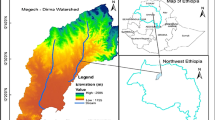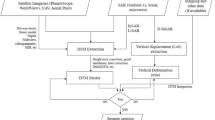Abstract
Terrace and check dam construction has substantially changed land surface morphology, which in turn affects modern surface processes. Digital elevation models (DEMs) provide an effective way to quantitatively analyze surface morphology and processes. However, existing DEMs lack sufficient ability to express artificial terrain. Based on 1:10000 topographic maps of the Zhifanggou watershed, a series of artificial terrain DEMs for the study site were constructed by both field investigation and remote sensing images from 1938 to 2010. Digital terrain analysis was used to quantitatively assess the influence of terrace and check dam construction on the watershed terrain. The results showed that the artificial terrain DEM could capture the spatial distribution patterns of terraces and dam lands and improved the ability of DEM to express terrain. The construction of terraces and check dams clearly changed the surface elevation. The average elevation change of each terrace mainly ranged between —1.5 and 1.5 m, while the annual average deposition height of the dam lands was 9.16 cm. The average slope, slope length, and slope length and steepness factor of the watershed decreased with the effect of the artificial terrain on the surface, and their averages decreased by 0.65°, 6.75 m, and 0.83, respectively, from 1938 to 2010. Although the construction of terraces reduced their surface slope to nearly 0°, the slope of terrace embankments rapidly increased, to more than 45°, which may lead to gravitational erosion and potential terrace damage. Terracing reduced the slope length in both the terrace distribution area and downslope of the terraces. Check dam deposition reduced the slope and slope length of the channel. This study contributes to a better understanding of the topographic change rules after terrace and check dam construction, and aids in elucidating the mechanisms of soil erosion process influenced by artificial topography.
Similar content being viewed by others
References
Bullock A, King B (2011). Evaluating China’s Slope Land Conversion Program as sustainable management in Tianquan and Wuqi Counties. J Environ Manage, 92(8): 1916–1922
Chen L D, Jia F Y, Wang Y F (2015). The effects of slope configuration and vegetation pattern on soil erosion in the loess hilly area. Scientia Geographica Sinica, 35(9): 1176–1182 (in Chinese)
Douglas I (1989). Land degradation, soil conservation and the sediment load of the Yellow River, China: review and assessment. Land Degrad Rehabil, 1(2): 141–151
Feng X M, Wang Y F, Chen L D, Fu B J, Bai G S (2010). Modeling soil erosion and its response to land-use change in hilly catchments of the Chinese Loess Plateau. Geomorphology, 118(3–4): 239–248
Huang M B, Zhang L (2004). Hydrological responses to conservation practices in a catchment of the Loess Plateau, China. Hydrol Processes, 18(10): 1885–1898
Hessel R, Asch van T (2003). Modelling gully erosion for a small catchment on the Chinese Loess Plateau. Catena, 54: 131–146
Hsieh H M, Luo C R, Yang J C, Chen R F (2013). Numerical study of the effects of check dams on erosion and sedimentation in the Pachang River. Int J Sediment Res, 28(3): 304–315
Hutchinson M F (1989). A new procedure for gridding elevation and stream line data with automatic removal of spurious pits. J Hydrol (Amst), 106(3–4): 211–232
Hutchinson M F (2004). ANUDEM Version 5.1 User Guide. 2004 Institute of Surveying and Mapping Standardization, State Bureau of Surveying and Mapping (2010). Digital Products of Fundamental Geographic Information.1:5000 1:10000 1:25000 1:50000 1:100000 Digital Elevation Models. Beijing: China Standards Press (in Chinese)
James L A, Hodgson M E, Ghoshal S, Latiolais M M (2012). Geomorphic change detection using historic maps and DEM differencing: The temporal dimension of geospatial analysis. Geomorphology, 137(1): 181–198
Jiang Z S, Liu Z, Jia Z W (1990). Research for relationships between topographic factors and loss of soil and water on sloping land. Memoir of NISWC. Academia Sinica & Ministry of Water Conservancy, 12: 1–8 (in Chinese)
Leopold L B (1992). Base level rise: gradient of deposition. Isr J Earth Sci, 41: 57–64
Lesschen J P, Cammeraat L H, Nieman T (2008). Erosion and terrace failure due to agricultural land abandonment in a semi-arid environment. Earth Surf Process Landf, 33(10): 1574–1584
Lesschen J P, Schoorl J M, Cammeraat L H (2009). Modelling runoff and erosion for a semi-arid catchment using a multi-scale approach based on hydrological connectivity. Geomorphology, 109(3–4): 174–183
Li B C (1995). Soil and Water Loss and Comprehensive Management of Small Watersheds by Remote Sensing. Beijing: Science Press (in Chinese)
Liu B Y, Nearing M A, Risse L M (1994). Slope gradient effects on soil loss for steep slopes. Trans ASAE, 37(6): 1835–1840
Liu B Y, Nearing M A, Shi P J, Jia Z W (2000). Slope length effects on soil loss for steep slopes. Soil Sci Soc Am J, 64(5): 1759–1763
Liu L, Liu X H (2010). Sensitivity analysis of soil erosion in the Northern Loess Plateau. Procedia Environ Sci, 2: 134–148
Li P, Xu G, Lu K, Zhang X, Shi P, Bai L, Ren Z, Pang G, Xiao L, Gao H, Pan M (2019). Runoff change and sediment source during rainstorms in an ecologically constructed watershed on the Loess Plateau, China. Sci Total Environ, 664: 968–974
Mu X M, Zhang L, McVicar T R, Chille B, Gau P (2007). Analysis of the impact of conservation measures on stream flow regime in catchments of the Loess Plateau, China. Hydrol Processes, 21(16): 2124–2134
Ran D C, Luo Q H, Liu B, Wang H (2004). Effect of soil-retaining dams on flood and sediment reduction in middle reaches of Yellow River. J Hydraul Eng, 5(5): 7–13 (in Chinese)
Renard K G, Foster G R, Weesies G A, McCool D K, Yoder D C (1997). Predicting Soil Erosion by Water: A Guide to Conservation Planning with the Revised Universal Soil Loss Equation (RUSLE). Washington: US Department of Agriculture
Ritsema C J (2003). Introduction: soil erosion and participatory land use planning on the Loess Plateau in China. Catena, 54(1–2): 1–5
Shi W J, Yang Q K, Zhao D B, Wei J J (2007). The research on generating a hydrologically correct DEM of mesoscale in the loess hilly region. Journal of Northwest A&F University, 35(2): 143–148 (in Chinese)
Smith D D, Wischmeier W H (1957). Factors affecting sheet and rill erosion. Trans Am Geophys Union, 38(6): 889–896
Smith M J, Clark C D (2005). Methods for the visualization of digital elevation models for landform mapping. Earth Surf Process Landf, 30(7): 885–900
Tang K L (2004). Soil and Water Conservation in China. Beijing: Science Press (in Chinese)
Tarolli P (2014). High-resolution topography for understanding earth surface processes: opportunities and challenges. Geomorphology, 216: 295–312
Wang H J, Yang Z S, Saito Y, Liu J P, Sun X X, Wang Y (2007). Stepwise decreases of the Huanghe (Yellow River) sediment load (1950–2005): impacts of climate change and human activities. Global Planet Change, 57(3–4): 331–354
Wang S, Fu B J, Piao S L, Lü Y H, Ciais P, Feng X M, Wang Y (2016). Reduced sediment transport in the Yellow River due to anthropogenic changes. Nat Geosci, 9(1): 38–41
Wischmeier W H, Smith D D (1978). Predicting Rainfall Erosion Losses: A Guide to Conservation Planning. Agriculture Handbook 537. Washington D C: US Department of Agriculture
Wu F Q, Zhang Y B, Wang J (2004). Study on the benefits of level terrace on soil and water conservation. Science of Soil and Water Conservation, 2(1): 34–37 (in Chinese)
Xu Y, Yang B, Liu G B, Liu P L (2009). Topographic differentiation simulation of crop yield and soil and water loss on the Loess Plateau. JGeogrSci, 19(3): 331–339
Yang Q, Zhao Z Y, Chow T L, Rees H, Bourque C P A, Meng F R (2009). Using GIS and a digital elevation model to assess the effectiveness of variable grade flow diversion terraces in reducing soil erosion in northwestern New Brunswick, Canada. Hydrol Processes, 23(23): 3271–3280
Yang Q K, Guo W L, Zhang H M, Wang L, Cheng L, Li J (2010). Method of extracting LS factor at watershed scale based on DEM. Bulletin of Soil and Water Conservation, 30(2): 203–206 (in Chinese)
Yang Q K, Zhang C X, Li L T, McVicar T R, Van Nie T G (2006). Optimizing DEM resolution with information content analysis. Journal of Yangtze River Scientific Research Institute, 23(5): 21–23 (in Chinese)
Zhang C X, Yang Q K, Duan J J (2006). Method for establishing high resolution digital elevation model. J Hydraul Eng, 37(8): 1009–1014 (in Chinese)
Zhang H M, Yang Q K, Li R, Liu Q R (2012). Estimation methods of slope gradient and slope length in watershed based on GIS and multiple flow direction algorithm. Transactions of the Chinese Society of Agricultural Engineering, 28(10): 159–164 (in Chinese)
Zhang H M, Yang Q K, Li R, Liu Q R, Moore D, He P, Ritsema C J, Geissen V (2013). Extension of a GIS procedure for calculating the RUSLE equation LS factor. Comput Geosci, 52: 177–188
Zhang H M, Yang Q K, Liu Q R, Guo W L, Wang C M (2010). Regional slope length and slope steepness factor extraction algorithm based on GIS. Computer Engineering, 36(9): 246–248 (in Chinese)
Zhao G J, Mu X M, Wen Z M, Wang F, Gao P (2013). Soil erosion, conservation, and eco-environment changes in the Loess Plateau of China. Land Degrad Dev, 24: 499–510
Zhu X M (1981). The main types of water erosion in the Loess Plateau and its impact factors. Bulletin of Soil and Water Conservation, 1(14): 13–18 (in Chinese)
Zingg A W (1940). Degree and length of land slope as it affects soil loss in runoff. Agric Eng, 21(2): 59–64
Acknowledgements
This work was supported by the National Natural Sciences Foundation of China (Grant Nos. 41601290, 41371274), the Natural Sciences Foundation of Shaanxi province, China (No. 2014JQ5182), and the Natural Sciences Foundation of Northwest University, China (No. NI14001).
Author information
Authors and Affiliations
Corresponding author
Rights and permissions
About this article
Cite this article
Pang, G., Yang, Q., Wang, C. et al. Quantitative assessment of the influence of terrace and check dam construction on watershed topography. Front. Earth Sci. 14, 360–375 (2020). https://doi.org/10.1007/s11707-019-0782-8
Received:
Accepted:
Published:
Issue Date:
DOI: https://doi.org/10.1007/s11707-019-0782-8




